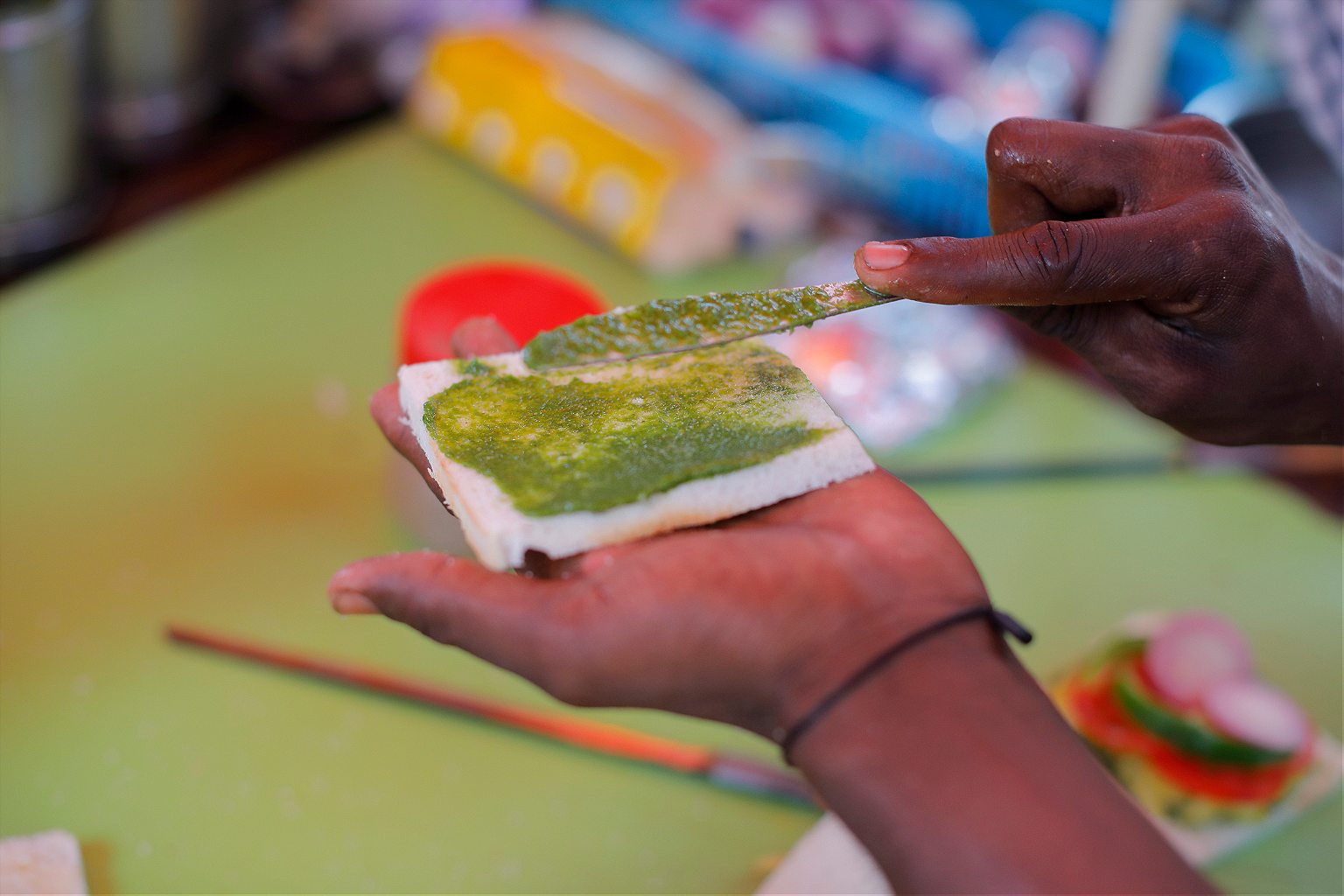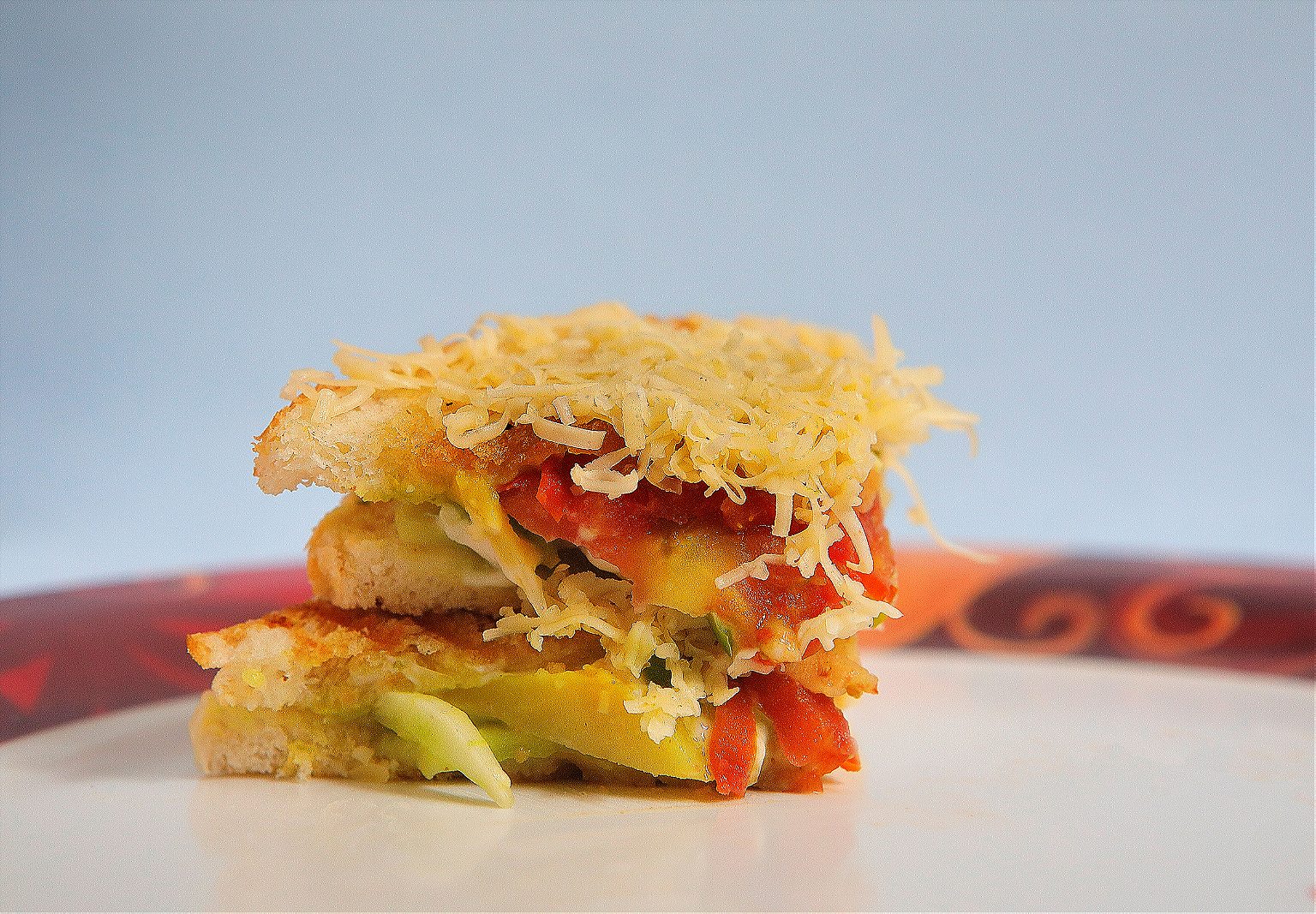Like many of the city’s most popular street snacks, the veg toast is a gleeful amalgam of influences drawn from the many communities who built the city.
There is no perfect dish in Bombay.
You’ll find very good idli and dosa in the leafy South Indian enclave of King’s Circle, but nothing to compare with what you’ll find in Tamil Nadu. There are some outstanding Keralite and Gujarati thalis—at Deluxe and Thacker’s, respectively—but they pale in comparison to what you might eat in Kerala or Gujarat. Chaat—that seemingly infinite variety of snacks made from fried doughs and chutneys, whose mixture of sweet and sour, hot and cold, spicy and sweet is a favorite culinary metonym for the Island City’s hopelessly mixed-up character—is better, though I’m loath to admit it, in the smog-choked alleys of Old Delhi. Even the spicy, seafood-heavy cuisine of the city’s pre-colonial inhabitants is better down the coast where the sea’s not murky with grey water.
But then there is the Bombay sandwich, available on virtually every corner of this cramped metropolis and all but impossible to find beyond the limits of its shockingly compact urban footprint.
Most sandwichwallahs can make at least a dozen varieties of sandwich, but my favorite is the classic veg toast, about as simple a dish as you could ever hope to find. The sandwichwallah begins with two pieces of Wibs bread—a sliced white bread made in the heart of Mumbai since 1973—smeared with chili-spiked mint-and-cilantro chutney. He’ll use a long, thin knife that waggles like a singing saw to turn out a dozen or so slices of vegetables: a thick bed of boiled potato, yellowed with a sulphuric flurry of chaat masala, followed by cucumber, beetroot, red onion, green bell pepper, and a second sprinkling of spices.
He’ll grease the inside of an iron sandwich clamp, called a chimta (meaning pressed or squeezed in Hindi), with a hefty dab of salted Amul-brand butter, place the sandwich inside, then nestle the closed clamp on a round, soot-black stand over red hot coals. After a few swift flips, he’ll open the clamp, slide the sandwich—sealed now on all sides, like a rhomboid flying saucer—onto a paper plate, cut it into six pieces, slather it with more butter, more chutney, and, if you like (believe me: you do), a pretty spiral of sweet ketchup. The final flourish is a tangled nest of wispy, deep-fried chickpea batter, called sev. When I said simple, I guess I meant for a city of notoriously baroque sensibilities.


From this starting point, the sandwichwallah offers a practically limitless array of permutations. Add cheese. Subtract beets. Potatoes and chutney only, please, and light on the masala. Eat your sandwich untoasted, or ask, in a naïve attempt to be ‘healthy’ (n.b. there is no healthy when there’s this much butter involved), for whole-grain bread. Some of the more enterprising sandwichwallas—including the beloved Singh Sandwichwallah outside the Jahangir Gallery in the historic Fort district—offer newfangled options like Szechuan toast, made with chopped vegetables and a vaguely “Chinese” mystery sauce (India’s understanding of the far east is about as nuanced as America’s understanding of India). There is a Bombay sandwich for every Bombaywallah, whoever she may be.
Like many of the city’s most popular street snacks, the veg toast is a gleeful amalgam of influences drawn from the many communities who, together, built the city. Bread and potatoes were introduced by the Portuguese, the sandwich format by the British. The sev comes from the state of Gujarat; the masala comes from chaat, with its origins up north. The vegetables are from India (cucumber, onion) and elsewhere (capsicum, beet); all are easily and cheaply available. The chutney, made from exceedingly common ingredients, is, in this form, more or less an invention of the Island City. All that butter suits the decadent palates of Gujaratis, who were among the first traders and merchants attracted to the British port. Wibs bread was developed 45 years ago by Parsis, descendants of Persian Zoroastrian immigrants who first came to South Asia 1300 years ago, and who have had an outsize influence on Bombay’s culture since its founding.
Cheap and filing and easy to prepare, the Bombay sandwich is one of many street foods developed to feed the city’s huge, diverse working and mercantile classes, the people who, working day and night, transformed a swampy clutch of islands into one of the world’s greatest, most storied cities. The Bombay sandwich is the city’s entire polyglot history – not in a nutshell, but crammed between two pieces of bread.

I ate my first veg toast roughly a week after I moved to Mumbai in January of 2012 while living in a neighborhood called Parel (not to be confused with the similarly named, but fancier, Lower Parel on the more fashionable western side of the tracks). Starting in the 19th century, this was textile mill territory, the city’s economic engine until the devastating, year-long labor strikes of 1982. It’s also an area generally associated not with sandwichwallahs, but with Mumbai’s most emblematic street snack, the vada pav: a spiced potato patty dipped in chickpea batter, deep fried, then shoved into a soft white roll with chilies and red chutney.
Where the Bombay sandwich belongs to no one, the popularization of the vada pav stems from a regionalist political movement in the 1960s, led by a right-wing local party called the Shiv Sena. The group’s explicit aim was to remake (or reclaim, depending on who you ask) cosmopolitan Bombay as a regional city called Mumbai that would favor Marathi-speaking Hindus from the surrounding state of Maharashtra. The movement was reactionary and obviously revisionist, but also powerful, stoking tensions between ethnic groups and promoting the idea that immigrants—South Indians then, North Indians and Muslims today—were invading the city and stealing jobs the so-called “sons of the soil.”
When the mill industry collapsed following the ’82 strikes, many of the Maharashtrians employed by it started setting up street stalls, with the help of the Sena, to sell vada pav. Suddenly, a snack made almost entirely of Columbian-exchange ingredients achieved the status of totem, a symbol of ethnic solidarity in times of economic distress, of regional ‘authenticity’ in a city built by immigrants. The Bombay sandwich, also developed to fill the guts of migrant workers, never earned itself a legend to match its ubiquity.
The collapse of the mills also opened a glut of land in the space-starved metropolis. In 1995, the same year that Bombay became Mumbai, the city government formed a committee, led by renowned architect Charles Correa, that proposed, among other forward-thinking notions, committing a third of all defunct mill land to public space. By 2005, greedy developers and their government accomplices, empowered by India’s post-liberalization yen for American-style capitalism on steroids, had negotiated the Correa plan’s guidelines into oblivion.
By the time I arrived in the city less than a decade later, population density had reached 74,000 people per square mile. The mill lands were a mess of office buildings and malls, the only ‘public’ space secreted away in commercial compounds, cut off from the street by metal detectors and security guards. The mixed-up city of the Bombay sandwich had decisively become the city of the vada pav.
While change in Mumbai is often swift and brutal, it is also almost always incomplete. The tower I lived in (and, frankly, hated) for my first six months in the city was one of a half dozen recent constructions along a narrow road, brutalized by constant construction. From my kitchen window, a popular breeding place for neighborhood pigeons, I could see the rotting corpse of a defunct mill. Between all these towers, built into the dusty ditches that fringed what remained of the road, was my first Bombay toast stand.
My toast-wallah was a whisper of a guy, tall and skinny with a scant moustache grown through pure force of will. Like many street vendors, he dressed immaculately every day in what appeared to be the same outfit (his was flared khakis and a blue plaid button-down). He wore his impressive wave of glossy black hair combed high across his scalp. He smiled constantly, but never showed his teeth. His fingernails were carefully trimmed. He always made a perfect sandwich. One stall over was a vada pav vendor, bent all day over his vat of boiling oil. Everyone who came through—mostly students from the surrounding colleges, but also nannies and drivers working for the rich people in the apartment towers—ate at both stands. Good food has a habit of crossing artificial cultural boundaries, especially in a city as full as Mumbai.
For about six months, I went to my sandwichwallah nearly every day, taking the occasional break for a starch-bomb vada pav. We didn’t talk much; he was shy and always had a crowd to feed. Even still, the relationship felt oddly intimate, which is what happens, I guess, when a person makes you food that often using his bare hands.

I didn’t stay long in that neighborhood, moving instead to a tiny shack that I called a cottage in an informal settlement in a nicer part of town. I found other sandwichwallahs, but their Bombay toasts never tasted quite the same—not, I don’t think, because they were objectively any less good, but because they were made by different hands. That insistence on physical proximity, on human contact, on the beautiful inevitability of impurity and contamination is what Mumbai, with all its chaos and madness and imperfection, still represents, whatever else may have changed in the last two decades.
I left Mumbai about two years ago—quickly, unexpectedly, not because I wanted to; a torrid first love affair that ended, as such things usually do, in disaster—and have not been able to go back since. I live in Mexico City now, equally huge, equally beautiful, equally complicated (though about a third as dense and with far more green space to go around). I miss a great many things about the city I called home for nearly five years. I miss the tropical air and the banyan trees and all that glorious, crumbling Victoriana. I miss chaat and searing fish curries and the taste of an ice-cold, piss-poor beer when I’m sweaty and dust-covered and breathless with over-stimulation. But one of the things I miss most is Bombay toast, something that should be easy to replicate but that never, ever tastes the same.
It’s tempting to make the sandwich a symbol—its many layers of different ingredients forced together by metal and heat, its distinct textures and flavors, its irreverent mixture of the foreign and the Indian—just as the Shiv Sena has made a symbol of the vada pav. But good food makes a lousy symbol. Bombay toast, finally, is just a snack, and also maybe a kind of communion, and in its way, it’s perfect.